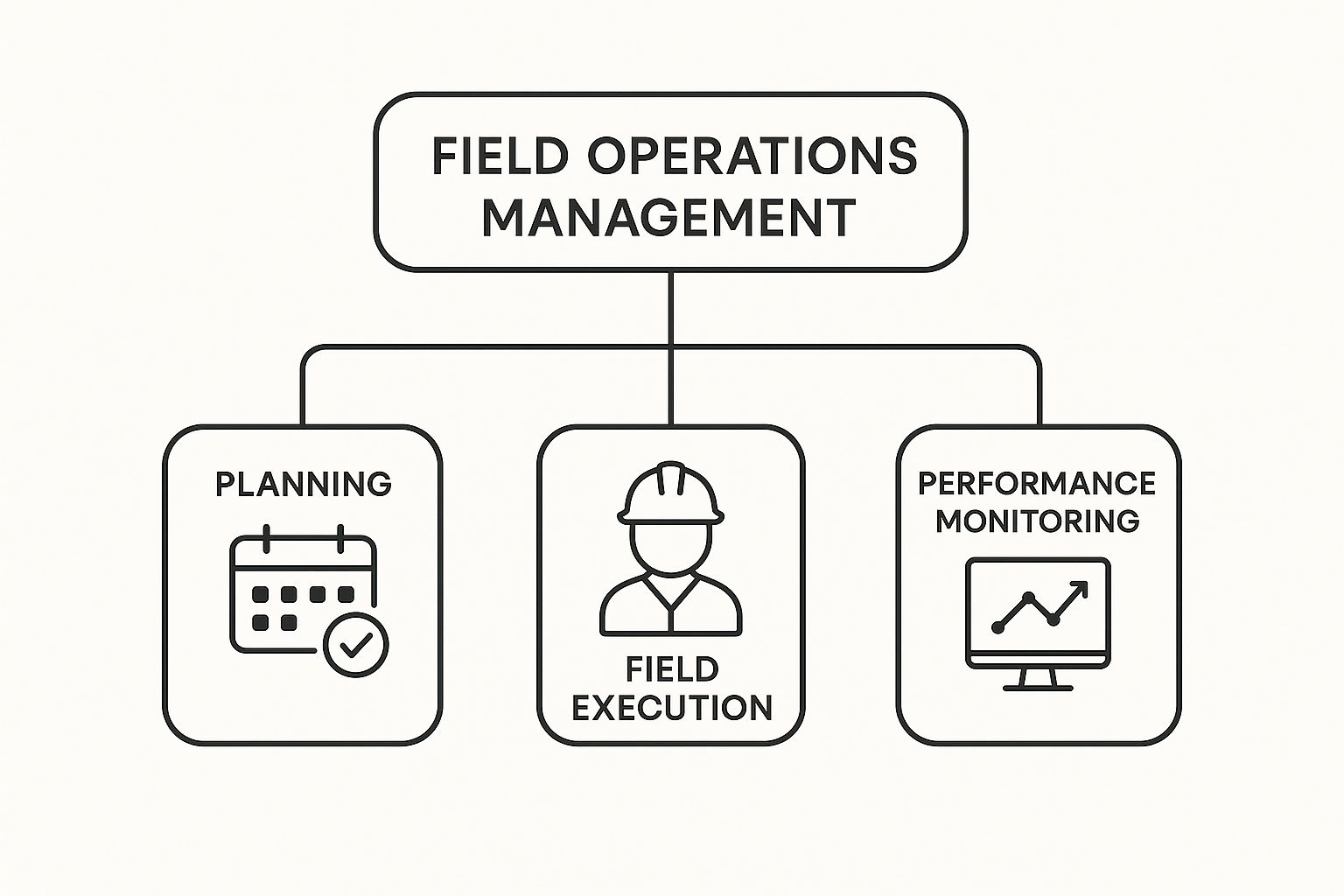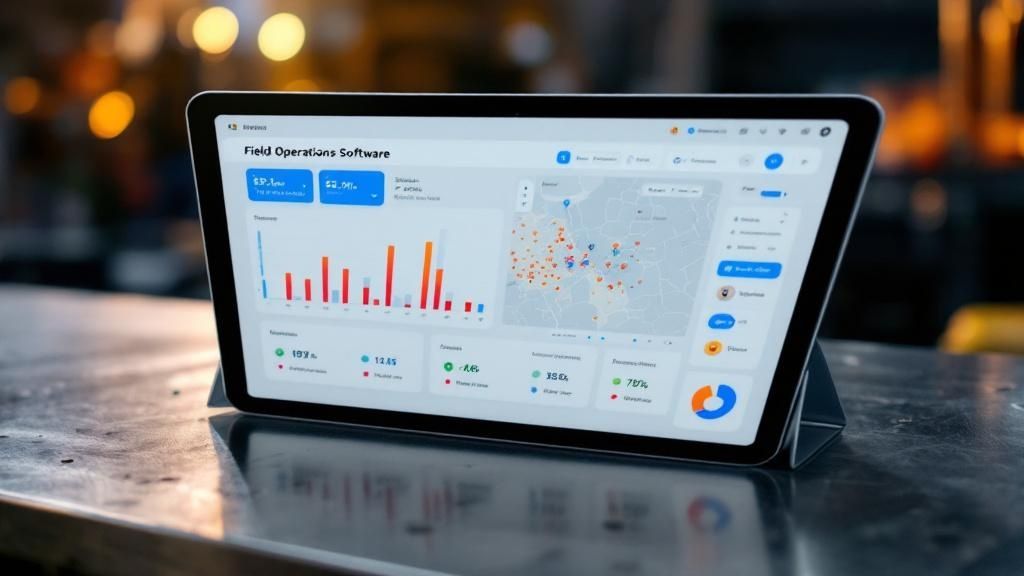Field operations management is, at its core, the art and science of managing everything that happens outside your office walls. It’s about orchestrating your mobile workforce—your technicians, inspectors, and service crews—to make sure they’re delivering top-notch service safely, efficiently, and in a way that leaves customers happy.
Think of it as the central nervous system for any business with teams on the move.
Understanding What Field Operations Management Means
Imagine an orchestra conductor. Their job is to guide dozens of musicians, each playing a different part, to create a flawless symphony. That’s a perfect metaphor for field operations management. It’s the behind-the-scenes work that ensures the right technician shows up to the right place, at the right time, with the exact tools and knowledge they need to solve the problem on the first try.
This goes way beyond simple dispatching. It's a comprehensive strategy that bridges the gap between your back-office staff and your field teams, creating a smooth, two-way street for information and work orders. When you get this right, it becomes a serious engine for growth. You’ll see customer satisfaction climb, operational costs drop, and even employee morale improve.
The secret is out, and the demand for tools to manage these processes is exploding.
The global field service management (FSM) market was valued at $5.2 billion in 2021 and is on track to hit nearly $30 billion by 2031. That's a compound annual growth rate of about 13.3%, fueled by the growing need for smart, digital tools to manage remote teams. You can dive deeper into the numbers in this field service management software analysis.
The Core Pillars of Effective Operations
To really get a handle on field operations management, it helps to break it down into its essential parts. These pillars are the foundation of any strong, responsive, and efficient operational strategy. Each one tackles a specific challenge of managing a mobile team, from the initial planning stages to reviewing performance after the job is done.
The following infographic illustrates the three high-level stages that make up any field operation.

As the diagram shows, success isn't a one-and-done deal. It’s a continuous cycle of planning, executing, and monitoring.
To build on that, let's look at the foundational pillars that support this cycle. The following table breaks down the key components of a solid field operations strategy and why they matter to the business.
Core Pillars of Field Operations Management
By getting a firm grip on these pillars, a business can stop putting out fires and start building a proactive, strategic advantage. It's all about creating a well-oiled machine where every moving part works in perfect harmony, delivering exceptional results for your company and, most importantly, for your customers.
The Shift from Clipboards to Cloud Platforms
Remember the days of paper maps, overflowing filing cabinets, and frantic check-in calls? It wasn't that long ago. A field technician’s entire day hinged on a stack of printed work orders, a well-worn map, and constant back-and-forth with the office. This old-school manual approach was painfully slow, riddled with errors, and created a massive disconnect between the people in the field and the team at home base.

The switch to digital wasn't just about getting shiny new tablets. It was a change born from two powerful, undeniable pressures. First, customer expectations shot through the roof. In a world where we can track a pizza to our doorstep, clients simply won't put up with vague arrival windows or a second visit because a technician forgot a part. They expect precision, real-time updates, and a smooth experience from the moment they call.
Second, businesses finally woke up to the need for real-time data. They realized all that crucial information—job status, parts used, customer feedback—was trapped on paper forms or, even worse, just in a technician's memory. Unlocking that data in the moment meant the difference between putting out fires and preventing them from ever starting.
The Forces Pushing for Digital
This is why moving to cloud-based field operations management platforms became a matter of survival, not just a nice-to-have. These systems serve as the central nervous system for the entire operation, and a few key factors are pushing companies to get on board.
- The Need for Real-Time Visibility: Managers can't fly blind. They have to know where their technicians are, what job they're on, and what roadblocks they're hitting right now. Digital platforms deliver this with a glance, using GPS tracking and instant status updates.
- The Pressure to Be More Efficient: To stay in the black, you have to eliminate wasted time. That means slashing unnecessary travel with smarter routes, killing duplicate data entry, and making sure every tech has what they need to get the job done right the first time.
- The Demand for Data-Driven Decisions: Guesswork is a luxury no business can afford. By collecting and analyzing operational data, companies can spot trends, predict future needs, and fine-tune everything from inventory levels to scheduling.
You can see this shift reflected in the money pouring into the industry. The global market for Field Service Management (FSM) software was valued at $6 billion in 2024 and is expected to surge to $11.5 billion by 2030. This growth is all about the intense demand for automation and clear visibility. For a deeper dive, check out the complete field service market outlook.
What This Digital Shift Actually Delivers
This isn't just about making workflows feel smoother; it's about getting real, measurable results that show up on the balance sheet. When businesses embrace cloud platforms, they give their teams the tools to be more nimble, proactive, and customer-obsessed. The change ties directly to the key performance indicators (KPIs) that really matter in field service.
For starters, you see a huge jump in first-time fix rates. Why? Because technicians show up knowing the job history and carrying the right parts. On top of that, intelligent scheduling and routing dramatically cut fuel costs and idle time, which means teams can fit more paying jobs into every single day. This investment isn't just about keeping up—it's how modern companies are building a serious competitive edge.
Navigating Daily Field Operations Challenges

While the theory of field operations management might sound straightforward, anyone who's actually managed a team knows the reality is far messier. The job isn’t just about overseeing a well-oiled machine; it’s about navigating a daily minefield of small problems that can explode into major setbacks at any moment.
Think about a single scheduling mistake. A technician gets sent to the wrong address. What happens next? The first customer is left waiting, a second job gets pushed back, and your technician wastes hours driving in circles. That one tiny error doesn't just disrupt a single schedule—it creates a ripple effect, frustrating multiple customers and stressing out your entire team.
This is the classic friction point for any business with a mobile workforce. The gap between the work you planned and what actually happens on the ground is where perfectly good profits leak away.
The High Cost of Small Mistakes
Those little inefficiencies rarely stay little. They have a nasty habit of compounding, chipping away at your profitability and damaging your reputation in ways you might not notice until it's too late. Most managers recognize these all-too-familiar patterns.
- Plummeting First-Time Fix Rates: Nothing sinks a job faster than a technician showing up without the right part or the correct customer history. It guarantees a second visit, instantly doubling your labor cost for that job and making your whole operation look disorganized.
- Wasted Time and Fuel: Inefficient routing is a silent profit killer. Sending technicians on winding, back-and-forth routes means they spend more time sitting in traffic than completing jobs. All that idle time adds up to higher fuel bills, more vehicle wear and tear, and fewer billable hours in a day.
- Technician Burnout and Turnover: No one likes being set up to fail. When your team is constantly dealing with scheduling mix-ups, angry customers, and a lack of information, the stress builds. Your best people get burned out, leading to high turnover and the endless, costly cycle of hiring and training replacements.
The real problem is a lack of real-time, accurate information. When the office is working with blind spots, they can't make smart dispatch decisions. And when technicians are in the field without the full picture, they can't do their best work.
When Communication Breaks Down
At the heart of most of these operational failures is a simple breakdown in communication. If the information flowing between your office staff and field crew is slow, spotty, or just plain wrong, you're practically inviting problems to happen.
Imagine a technician fixes a customer's HVAC unit but notices a secondary issue—say, a frayed wire—and forgets to log it. That tiny piece of intel vanishes. A month later, that frayed wire causes a complete system failure. Now you’re dealing with an emergency call-out, a furious customer, and a much more expensive repair that was entirely preventable.
This is where effective field operations management comes in. It’s about closing that communication gap so that every critical piece of information from the field gets captured and, more importantly, acted upon. This isn't just about damage control; it's about building a resilient, proactive operation that turns everyday challenges into opportunities to shine.
Proven Strategies for Operational Excellence

Knowing the challenges of field operations is one thing, but actually overcoming them requires a solid playbook. It’s time to shift from putting out fires to proactively building operational excellence with practical, tech-driven tactics. This isn't about lofty theories; it's about making real changes that deliver measurable results out in the field.
The goal here is to bridge the gap between your office and your field teams, turning daily friction into a well-oiled machine. When you arm your technicians with the right tools and information, you empower them to deliver top-notch service on every single call.
Embrace Mobile-First Tools
These days, a technician's most powerful tool isn't a wrench—it's the smartphone or tablet in their pocket. Going all-in on mobile-first platforms is probably the single most effective way to transform your field operations. Why? Because these tools put everything a technician could possibly need right at their fingertips.
Instead of lugging around clunky binders, they have instant access to job histories, customer notes, and digital manuals. This simple switch from paper to screen dramatically improves how prepared they are and seriously boosts first-time fix rates. It gives your team the power to solve problems on the spot, eliminating the need for a second trip because of forgotten info or parts.
Implement Dynamic Scheduling and Route Optimization
Static, pre-planned schedules are fragile. All it takes is one unexpected delay to throw the entire day into chaos. The answer is dynamic scheduling, which acts more like a GPS navigator than a printed map. It adapts on the fly to new jobs, surprise cancellations, and traffic jams.
Think about it like this: logistics companies use route optimization software to analyze traffic and job sites, creating the most efficient multi-stop route possible. This doesn't just get technicians to jobs faster—it saves a ton of money. Some companies have cut fuel costs by over 20% and squeezed more billable hours into every day.
Key Takeaway: Dynamic scheduling isn't just about being efficient; it's about being agile. It gives you the power to handle unexpected events without derailing productivity, turning potential chaos into a manageable hiccup.
This is a core pillar of effective field operations management, where smart automation takes over the complex job of reshuffling priorities.
Create a Centralized Communication Hub
When information is scattered across emails, texts, and random phone calls, you’re just asking for trouble. A centralized communication hub makes sure every piece of data—from a customer's request to a technician's note—lives in one, easy-to-find place. This single source of truth cuts down on confusion and ensures nothing gets missed.
For example, a technician can snap a photo of a completed job and upload it directly to the work order. The office staff sees it immediately, confirms the work is done, and can send out the invoice right away. This seamless information flow prevents miscommunication and massively speeds up the job-to-cash cycle. This is especially crucial in the booming field activity management market, which hit $1.43 billion in 2024, driven by the need for better work order coordination.
Focus on Data-Driven Performance Management
You can't improve what you don't measure. Ditching gut feelings for hard data is absolutely essential for achieving operational excellence. Modern field service platforms come with dashboards that track key performance indicators (KPIs) in real time.
Here are a few critical metrics to watch:
- First-Time Fix Rate: The percentage of jobs done right on the first visit. This is a huge indicator of both technician skill and how well-prepared your team is.
- Average Time to Completion: How long a job takes, from dispatch to final sign-off. Tracking this helps you find efficiencies and spot areas for more training.
- Technician Utilization: The amount of a technician's time spent on billable work versus driving or waiting around.
For businesses in the home services space, a key part of operational excellence is boosting lead generation for home services to keep a steady flow of work for your field teams. By analyzing these numbers, managers can spot trends, reward your top people, and give targeted coaching to lift the entire team. Embracing these proven strategies can turn your field operations from a cost center into a powerful competitive edge.
How AI Is Completely Changing the Game in Field Operations
So, we've covered the best practices, but let's shift gears and talk about the technology that's truly pushing the boundaries. Think of managing your field team the old way—it’s like navigating a new city with a crumpled paper map. Now, imagine using Waze. That’s AI. It doesn't just give you a route; it sees the traffic jam forming three miles ahead and silently redirects you to save time.
This isn't some far-off, futuristic idea. It's happening right now. AI is a practical, powerful tool that’s already giving businesses a serious competitive advantage. The fundamental shift is moving from a reactive to a proactive mindset. Instead of just putting out fires, AI helps you predict where they'll start, so you can prevent them altogether. It chews through mountains of data in seconds, spotting patterns and making connections that a human manager, no matter how experienced, simply couldn't.
Intelligent Scheduling and Dynamic Routing
One of the first and most obvious wins with AI is in scheduling and dispatching. Anyone who's tried to build a daily schedule manually knows it's a house of cards. One emergency call or a job that runs long can bring the whole thing crashing down.
AI-powered scheduling, on the other hand, embraces that chaos. An AI algorithm can juggle thousands of factors at once—a technician's specific skills, the customer's location, live traffic data, which parts are on the truck, and even the job's priority level—to craft the most efficient schedule imaginable. When a high-priority job lands, the system doesn't just tack it on the end. It instantly re-optimizes the entire day for multiple technicians, minimizing travel and disruption.
This naturally leads to smarter routing. It's no longer about just finding the shortest distance from A to B. AI figures out the most logical sequence of jobs for the entire day, ensuring technicians spend more time working and less time stuck in traffic. The impact is immediate: lower fuel costs and higher productivity.
For example, imagine an HVAC company gets an urgent call for a complex commercial repair. The AI instantly assigns it to the most senior technician. At the same time, it sees a new, routine maintenance request pop up just a few blocks from a junior tech's current location and reroutes them. All of this happens automatically, without a single frantic phone call from the dispatcher.
Predictive Maintenance and Proactive Service
This is where AI really starts to shine. For decades, most companies have been stuck in a break-fix cycle. You wait for a customer's equipment to fail, then you rush a technician out to fix it. It's inefficient, expensive, and a great way to frustrate customers.
AI flips this model on its head by enabling predictive maintenance. By analyzing data from equipment sensors, historical usage, and even weather patterns, it can predict when a part is likely to fail, often weeks in advance. This means you can schedule a service visit on your terms, not during a customer's crisis.
The benefits here are huge:
- Reduced Downtime: Your customers experience fewer surprise outages, which is a massive boost for their satisfaction and loyalty.
- Lower Repair Costs: A planned maintenance visit is almost always cheaper and less disruptive than a panicked, after-hours emergency call.
- Improved Resource Planning: You know exactly which parts you'll need ahead of time, which cleans up your inventory management and prevents stockouts.
This proactive approach transforms your field team. They're no longer just reactive problem-solvers; they become trusted partners who keep their customers' operations humming along.
Smarter Data Capture and Reporting
Let's be honest: paperwork is the bane of every field technician's existence. Manually filling out forms, typing up notes, and logging job progress is tedious, slow, and full of potential errors. This is another area where AI is providing massive relief.
Tools like ResQ’s AI assistant, Nora, are using technologies like voice-to-text to completely automate this process. A technician can simply send a quick voice note, a photo of the completed work, or a short video explaining the situation. The AI takes over from there—transcribing, organizing, and tagging the information into clean, structured notes right in the job file.
This completely eliminates the need for manual data entry at the end of a long day, freeing up technicians to focus on what they do best. More importantly, it means the back office gets accurate, real-time information for invoicing, tracking progress, and creating follow-up work orders. By automating job logging, AI closes the gap between the field and the office, dramatically speeding up the work-to-cash cycle and all but eliminating administrative mistakes.
Selecting Your Field Operations Software
Picking the right software for your field team isn't just about buying a new tool—it's more like hiring a critical new team member. You need a partner that fits your business, grows with you, and genuinely makes everyone's job easier. With so many options on the market, it’s all too easy to get sidetracked by flashy features that don't solve your real problems. A structured approach is key.
Think of this as a strategic decision, not just a purchase. You need to cut through the marketing noise and zero in on the core functions that will actually improve your daily workflow, boost your team's performance, and strengthen your bottom line.
Your Core Evaluation Checklist
Before you even think about scheduling a demo, you need a solid checklist. These are your non-negotiables—the must-have features that separate a true operational asset from just another monthly subscription fee. This framework will help you make a smart, long-term investment.
Start by asking tough questions. It's not just about what the software can do, but how it will slot into your existing operations and support your team where they need it most.
Here’s a practical list to get you started:
- Scalability for Growth: Can this platform handle your business if you double your field team in the next two years? Look for flexible pricing and features you can grow into, not out of. A massive platform like Procore is great for large construction firms but might be overkill for a smaller service team.
- Seamless System Integration: Your business likely already relies on other tools, like a CRM for customer info or an ERP for financials. Your field software absolutely must connect with these systems. Without that, you’re just creating frustrating data silos and more manual work for your team.
- User-Friendliness for All: The best software is useless if no one wants to use it. The platform needs to be intuitive for everyone—from the admin staff in the office to the technicians out on a job. A clunky mobile app is a deal-breaker for field crews.
The ultimate test of any field software is user adoption. If it isn't simple for a technician to quickly log notes or complete a report, they won't do it. This is why features like voice-to-text are so valuable—they fit naturally into the fast pace of fieldwork.
Aligning Software with Your Strategy
Beyond the basic checklist, the right software should directly support your bigger business goals. Are you trying to improve first-time fix rates, cut down on fuel costs, or expand your service area? Your software should be a powerful tool that actively helps you get there. For instance, good workforce management software is a game-changer when it comes to streamlining operations and improving efficiency.
Look at how a platform handles data. Does it give you clear, insightful analytics that help you spot trends in job profitability or technician performance? Making decisions based on data, not just gut feelings, is what separates good field operations from great ones. Your software needs to provide that crucial information.
Finally, don't overlook the onboarding and support. A fantastic product backed by terrible support is a recipe for disaster. Look for a vendor who acts like a partner, offering solid training, responsive help, and a clear plan to get you up and running. Taking the time to choose carefully means you’re investing in an operational partner, not just buying another piece of tech.
Answering Your Top Field Operations Questions
Even with the best plan in place, real-world questions always pop up when you start refining your field operations. Let's tackle some of the most common ones we hear from managers and business owners. Think of this as a quick guide to navigating the change, justifying the investment, and seeing a real impact on your team.
What’s the First Step to Improving My Field Operations?
Before you even think about new software or tools, take a good, hard look at your current workflow. A simple audit is the best place to start. Don't jump to solutions—first, find your biggest headaches.
Are you constantly dealing with scheduling mix-ups? Are your technicians making too many repeat visits? Or is the communication between your office and field crew completely broken? Pinpointing exactly where you're losing time and money will show you where to focus for the biggest, fastest wins. This way, you’re solving actual problems, not just buying tech for tech's sake.
How Do I Get My Field Techs to Actually Use New Software?
This is a big one, and the answer is simple: the new tool has to make their job easier, not harder. The secret is getting your technicians involved from day one. Let them get their hands on a few different mobile apps and tell you what feels intuitive and what’s a pain to use.
When you do roll out the new system, frame the training around what’s in it for them.
- No More Paperwork: Show them how they can ditch the clipboard and use digital forms or even voice-to-text to wrap up their day without a mountain of admin.
- The Right Info, Right Now: Point out how having job histories and manuals on their phone means no more guessing games or calls back to the office.
- Smarter Routes, Not Harder Miles: Explain how route optimization gets them out of traffic and lets them focus on billable work.
A study on the adoption of field management software found that tools with easy-to-use mobile interfaces and handy features like voice-to-text—such as Raken—see much higher buy-in. When the tool visibly helps, technicians are eager to use it.
Can a Small Business Really Benefit from This Kind of Software?
Absolutely. In fact, small businesses often see the most significant and immediate benefits. Today’s field operations management software is built to scale and is usually sold as a monthly subscription, which makes it totally affordable for teams of any size.
The real value comes from the efficiency boost. For a small team, cutting fuel costs by 15-20% or squeezing just one extra job into each tech’s day can make a huge difference to your bottom line. These tools help level the playing field, empowering smaller companies to compete with the big guys on service and speed.
Ready to stop chasing down manual notes and get your field and office teams on the same page? See how Nora uses AI to turn simple WhatsApp updates into perfectly structured job notes. See how Nora can transform your field operations.



